Spatio-Temporal Evolution and Identification of Obstacles to High-Quality Economic Development in the Yellow River Basin
Abstract
1. Introduction
2. Materials and Methods
2.1. Research Methods
2.1.1. Construction of the Indicator System for HQED in the YRB
- (1)
- Innovative Capability: Innovation is a critical driving force behind economic growth and social progress. The level of human capital reflects the cultivation of talent for innovation, while the ratio of scientific and technological fiscal expenditures to local general public budget expenditures indicates the investment in innovation. The number of invention patents authorized per ten thousand people serves as a measure of a region’s innovation output.
- (2)
- Coordinated Capability: There exists a significant gap in economic and developmental levels between the upstream, midstream, and downstream areas of the YRB, as well as among different provinces. As such, collaborative development is essential to achieve regional coordination. The income and consumption disparity between urban and rural areas reflects the degree of urban–rural coordination in a region. The advanced industrial structure index and rationalization index provide insights into the level of industrial structure coordination.
- (3)
- Green Development Capability: As a crucial ecological protection zone, the YRB plays a vital role in the overall ecosystem, and its green development capability significantly impacts environmental quality and ecological balance. The industrial sulfur dioxide emissions per unit of GDP reflect the region’s pollution emission efficiency. Moreover, the proportion of energy-saving and ecological environmental protection expenditures in the fiscal budget highlights the government’s commitment to environmental protection in the YRB. Water consumption per unit of GDP indicates the utilization of water resources in the area, while the comprehensive utilization rate of industrial solid waste reflects resource recycling within the region. Finally, the green coverage rate of built-up areas signifies the sustainable development potential of the YRB’s environment.
- (4)
- Open and Shared Capability: Openness and sharing are essential pathways for establishing a mutually reinforcing dual cycle of domestic and international markets and are critical for enhancing a region’s competitiveness in economic development. The proportion of total goods imported and exported to GDP illustrates the region’s dependence on foreign trade. The actual utilization of foreign direct investment as a percentage of GDP reflects the region’s use of foreign capital. The number of hospital doctors per ten thousand people indicates the availability of healthcare resources, while the proportion of social security and employment spending within the fiscal budget reflects the social and employment support aspects of residents’ lives. Additionally, the number of broadband internet access users per ten thousand people, the per capita road area, and the gas coverage rate demonstrate the status of infrastructure development in the region.
2.1.2. CRITIC Method
2.1.3. Dagum Gini Coefficient
2.1.4. Exploratory Spatial Data Analysis
- (1)
- Global autocorrelation. Global autocorrelation primarily assesses the overall spatial correlation and regional discrepancies during the HQED of the YRB [39]. Its calculation formula is as follows:
- (2)
- Local autocorrelation. Local autocorrelation primarily examines the spatial correlation of index changes within and between neighboring regions and, combined with visual processing, reveals the spatial heterogeneity of the changes in HQED levels in the YRB [40].
2.1.5. Markov Chain
2.1.6. Obstacle Degree Model
3. Results and Analysis
3.1. Temporal Evolution Characteristics of HQED in the YRB
3.1.1. Analysis of Differences in HQED Levels Across Different Dimensions in the YRB
3.1.2. Analysis of Inter-Regional Relative Differences in High-Quality Economic Development Levels in the YRB
3.2. Spatial Differentiation Characteristics of HQED in the YRB
3.2.1. Spatial Differentiation Characteristics of HQED Levels in the YRB
3.2.2. Spatial Correlation Characteristics of HQED Levels in the YRB
- (1)
- Spatial Correlation Characteristics Based on Global Autocorrelation
- (2)
- Spatial Correlation Characteristics Based on Local Autocorrelation Indices
3.3. Analysis of the Dynamic Evolution Trends of HQED in the YRB
3.3.1. Temporal Evolution Trends of HQED Levels
3.3.2. Spatial Evolution Trends of HQED Levels
3.4. Barrier Factors to HQED Levels in the YRB
3.4.1. Criterion-Level Barrier Factors
3.4.2. Indicator-Level Barrier Factors
4. Discussion
4.1. Comparison with Existing Research
4.2. Universality of Obstacles to HQED
4.3. Limitations of This Study and Future Prospects
5. Conclusions and Recommendations
5.1. Conclusions
5.2. Recommendations
- (1)
- Promote systematic coordination and reduce regional disparities. Grounded in the “growth pole theory” and “gradient transition theory” from regional economics, sustainable development policies for river basins can establish mechanisms for regional collaboration to dismantle institutional barriers hindering the flow of resources. Enhancing the regional planning legislative framework and inter-regional management system can lower transaction costs and facilitate the rational allocation of resources, such as labor and capital. The interaction of “institution—factor—industry” not only helps to narrow regional development gaps but also unleashes the spatial dividends of economic growth, thereby maximizing overall effectiveness. This approach fosters stable and moderately rapid growth of the Chinese economy and encourages the formation of a unified national market, offering theoretical support and practical pathways for achieving coordinated development.
- (2)
- Strengthen ecological compensation and green development mechanisms. Given the dual challenges of ecological protection and economic development in the YRB, it is crucial to establish and enhance the ecological compensation mechanism, promote the realization of ecological product value, and encourage regional green development. By employing instruments, such as ecological compensation and green finance, enterprises and local governments can be incentivized to actively engage in ecological protection, facilitating a virtuous interaction between economic development and ecological conservation. This concept not only emphasizes the scale of economic growth but also prioritizes growth quality and long-term benefits, providing a model for high-quality national economic development while promoting ecological civilization and sustainable development in China.
- (3)
- Deepen reforms and innovations in key areas. According to the “theory of institutional change” in new institutional economics, reforms to the socialist market economy can release market vitality through institutional innovation. Reforms in the science and technology sector can promote collaboration between academia and industry, enhance research and development investment intensity, improve patent conversion rates, and increase the contribution of new forms of productivity to economic growth. Reform initiatives in the YRB, particularly in areas such as the digital economy and green low-carbon initiatives, will yield practical experiences for market-oriented resource allocation and innovation-driven development nationwide, promoting the construction of a modern economic system.
- (4)
- Expand open cooperation and coordinated linkage. Development in the YRB is hindered by administrative barriers, resulting in sluggish resource movement. Drawing on regional integration theory, it is imperative to dismantle these administrative obstacles. Utilizing the “Belt and Road” initiative and positioning the YRB as a central axis, countries and regions along the route can collaborate to create a “Belt and Road” green economic corridor. By optimizing the business environment and facilitating the free flow of talent, capital, and technology, regional competitiveness can be enhanced. This policy recommendation carries significant implications for other inter-regional economic cooperation across the nation and contributes to the efficient allocation of resources and the advancement of HQED on a national scale.
Author Contributions
Funding
Data Availability Statement
Acknowledgments
Conflicts of Interest
Abbreviations
| YRB | Yellow River Basin |
| HQED | High-Quality Economic Development |
References
- Song, J.J. Comparison and Prospect of Economic and Population Development in Seven Major River Basins. Nat. Resour. Econ. China 2023, 36, 14–20. [Google Scholar] [CrossRef]
- Yi, M. Research on the High-quality Development of China’s Basin Economy in the New Era—Analysis Based on Marxist Thought on Basin Economy. Contemp. Econ. Res. 2021, 2, 45–54. [Google Scholar]
- Ren, B.P.; Li, Y.M. On the Construction of Chinese High-quality Development Evaluation System and the Path of Its Transformation in the New Era. J. Shaanxi Norm. Univ. Philos. Soc. Sci. Ed. 2018, 47, 105–113. [Google Scholar] [CrossRef]
- Bei, J. Study on the “High-Quality Development” Economics. China Ind. Econ. 2018, 1, 163–180. [Google Scholar] [CrossRef]
- Liu, Z.B. Understanding the High-quality Development: Basic Features, Supporting Elements and Current Key-issues. Acad. Mon. 2018, 50, 39–45+59. [Google Scholar] [CrossRef]
- Zhao, J.B.; Shi, D. A Framework of China’s High-quality Economic Development. Res. Econ. Manag. 2019, 40, 15–31. [Google Scholar] [CrossRef]
- Geng, Y.; Sarkis, J.; Ulgiati, S.; Zhang, P. Measuring China’s Circular Economy. Science 2013, 339, 1526–1527. [Google Scholar] [CrossRef]
- Zhang, W.; Zhang, L.; Li, Y.; Tian, Y.; Li, X.; Zhang, X.; Mol, A.P.; Sonnenfeld, D.A.; Liu, J.; Ping, Z.; et al. Neglected environmental health impacts of China’s supply-side structural reform. Environ. Int. 2018, 115, 97–103. [Google Scholar] [CrossRef]
- Bain, P.G.; Kroonenberg, P.M.; Johansson, L.O.; Milfont, T.L.; Crimston, C.R.; Kurz, T.; Bushina, E.; Calligaro, C.; Demarque, C.; Guan, Y.; et al. Public views of the sustainable development goals across countries. Nat Sustain. 2019, 2, 819–825. [Google Scholar] [CrossRef]
- Mohanty, A.K.; Vivekanandhan, S.; Pin, J.M.; Misra, M. Composites from renewableand sustainable resources Challenges and innovations. Science 2018, 362, 536–542. [Google Scholar] [CrossRef]
- Li, Y.; Wu, M.S. Analysis of the Temporal and Spatial Coupling and Influencing Factors of Green Technological Innovation, Carbon Emission Reduction, and High-Quality Economic Development. Stat. Decis. 2023, 39, 77–81. [Google Scholar] [CrossRef]
- Gao, C.; Xie, Q.W.; Zheng, X.L. Financial Structure, Resource Allocation, and High-Quality Economic Development—A Study Based on Industry. J. Mod. Fin. 2025, 30, 44–55. [Google Scholar] [CrossRef]
- Ding, X.; Wu, Q.; Liu, X.; Tan, L.; Wang, J. Coupling and coordination degree of land use, high-quality economic development, and carbon emissions and influencing factors in China: An empirical study of 282 prefecture-level cities. Resour. Sci. 2022, 44, 2233–2246. [Google Scholar] [CrossRef]
- Wang, X. Digital New Quality Productivity, Digital New Quality Productivity, Domestic and International Circulation and High-quality Economic Development. Stat. Decis. 2024, 40, 17–22. [Google Scholar] [CrossRef]
- Guo, J.; Zhong, J.Y. Analysis of the Impact of Social Capital on High Quality Economic Development: Based on the perspective of environmental efficiency. Econ. Probl. 2023, 12, 73–80. [Google Scholar] [CrossRef]
- Zheng, P.Y.; Ren, D.W.; Niu, J.; Yang, G.H. Digital Infrastructure Construction, Allocation of Innovation Factors, and High-quality Economic Development. Stat. Decis. 2024, 40, 86–90. [Google Scholar] [CrossRef]
- Cheng, J.H.; Peng, X.J.; Li, J.Y.; Zhang, X.H.; Zhan, C. Transmission mechanism of the impact of environmental regulations on the high-quality economic development of the Yangtze River Economic Belt. Chin. J. Popul. Resour. Environ. 2024, 34, 126–136. [Google Scholar]
- Ma, R.; Zhang, J.; Wang, H.W. Do S&T Talents Contribute to High-quality Economic Development of China?—Empirical Test Based on Effect of S&T Talents on TFP. Res. Econ. Manag. 2019, 40, 3–12. [Google Scholar] [CrossRef]
- Li, P.; Fu, Y.F.; Zhang, Y.F. Can the Productive Service Industry Become New Momentum for China’s Economic Growth. China Ind. Econ. 2017, 12, 5–21. [Google Scholar] [CrossRef]
- Chen, M.H.; Zhang, X.M.; Liu, Y.X.; Zhong, C.Y. Dynamic Evolution and Trend Prediction of Green TFP Growth: An Empirical Study Based on Five Major City Clusters in China. Nankai Econ. Stud. 2020, 20–44. [Google Scholar] [CrossRef]
- Ma, R.; Luo, H.; Wang, H.W.; Wang, T.C. Study of Evaluating High-quality Economic Development in Chinese Regions. China Soft Sci. 2019, 7, 60–67. [Google Scholar]
- Chao, X.J.; Hui, K. Measurement of China’s Economic Growth Quality. J. Quant. Tech. Econ. 2009, 26, 75–86. [Google Scholar]
- Shi, B.; Ren, B.P. A Measurement of China’s Provincial Economic High Quality Development. Econ. Probl. 2018, 4, 1–6. [Google Scholar] [CrossRef]
- Liu, B.L.; Qin, W.J. Spatial Distribution and Dynamic Evolution of China’s High-quality Economic Development Level. China Soft Sci. 2022, 1, 62–75. [Google Scholar]
- Frolov, S.M.; Kremen, O.I.; Ohol, D.O. Scientific methodical approaches to evaluating the quality of economic growth. Act. Prob. Econ. 2015, 173, 393–398. [Google Scholar]
- Liang, Q.; Teng, J.Z. Financial development and economic growth: Evidence from China. China Econ. Rev. 2006, 17, 395–411. [Google Scholar] [CrossRef]
- Yang, Y.F.; Wang, Q. Research on construction of evaluation index system for high-quality development of regional economy in China in the New Era. China Soft Sci. 2024, S1, 182–190. [Google Scholar]
- Bu, W.; Liu, S.S.; Li, C.X. Measurement and Comparison of High-Quality Economic Development in Three Major City Clusters. Stat. Decis. 2024, 40, 103–107. [Google Scholar] [CrossRef]
- Hu, J.B.; Zhou, Z.K. Coordination of Carbon Intensity and High-Quality Economic Development for the Beijing-Tianjin-Hebei Urban Agglomeration under China′s Dual Carbon Goals. Geogr. Geo-Inf. Sci. 2024, 40, 116–123. [Google Scholar]
- Wang, S.W.; Chen, X.K. Measurement, Spatial Distribution and Dynamic Evolution of the High-quality Development Level of China’s Regional Economy. Stat. Decis. 2023, 39, 90–96. [Google Scholar] [CrossRef]
- Du, J.; Miao, C.H.; Xu, J.W.; Lyu, K.; Li, C. Spatial-temporal Pattern and Influencing Factors of High-quality Development in the Central Plains Urban Agglomeration. Econ. Geogr. 2025, 45, 67–76. [Google Scholar] [CrossRef]
- Sun, J.W.; Jiang, Z.; Hu, J.Y. Spatio-temporal evolution and driving factors of high-quality marine economic development in China. Acta Geogr. Sin. 2024, 79, 3110–3128. [Google Scholar]
- Li, M.X.; Ren, B.P. Comprehensive Evaluation and Path Selection of High-Quality Development in the New Era. Fin. Econ. 2019, 5, 26–40. [Google Scholar]
- Zhang, J.K.; Hou, Y.Z.; Liu, P.L.; He, J.W.; Zhuo, X. The Goals and Strategy Path of High-quality Development. J. Manag. World. 2019, 35, 1–7. [Google Scholar] [CrossRef]
- Sun, H.; Gui, H.; Yang, D. Measurement and evaluation of the high-quality of China provincial economic development. Zhejiang Soc. Sci. 2020, 8, 4–14. [Google Scholar]
- Chen, L.; Huo, C. The Measurement and Influencing Factors of High-Quality Economic Development in China. Sustainability 2022, 14, 9293. [Google Scholar] [CrossRef]
- Zhao, J.; Tian, L.; Ding, L.; Sun, H.; Li, P. Research on Energy-Environment-Economy-Ecology Coupling Development in the Yellow River Basin. E3S Web Conf. 2021, 267, 01003. [Google Scholar] [CrossRef]
- Dagum, C. A new approach to the decomposition of the Gini income inequality ratio. Empir. Econ. 1997, 22, 515–531. [Google Scholar] [CrossRef]
- Ma, X.D.; Hu, Y.; Huang, B. Spatial-temporal Characteristics and Influencing Factors of Rural Green Development in Jiangsu Province. Econ. Geogr. 2022, 42, 159–167. [Google Scholar] [CrossRef]
- Feng, X.H.; Qiu, S.Y. Measurement and Convergence of High-quality Economic Development in the Yangtze River Delta Cities. East China Econ. Manag. 2022, 36, 28–43. [Google Scholar] [CrossRef]
- Hu, S.; Jiao, S.; Zhang, X. Spatio-temporal evolution and influencing factors of China’s tourism development: Based on the non-static spatial Markov chain model. J. Nat. Resour. 2021, 36, 854–865. [Google Scholar] [CrossRef]
- Yang, X.; Feng, Z.; Chen, Y. Evaluation and obstacle analysis of high-quality development in Yellow River Basin and Yangtze River Economic Belt, China. Humanit. Soc. Sci. Commun. 2023, 10, 757. [Google Scholar] [CrossRef]
- Chen, Y.; Miao, Q.; Zhou, Q. Spatiotemporal Differentiation and Driving Force Analysis of the High-Quality Development of Urban Agglomerations along the Yellow River Basin. Int. J. Environ. Res. Public Health 2022, 19, 2484. [Google Scholar] [CrossRef] [PubMed]
- Feng, Z.; Chen, Y.; Yang, X. Measurement of Spatio-Temporal Differences and Analysis of the Obstacles to High-Quality Development in the Yellow River Basin, China. Sustainability 2022, 14, 14179. [Google Scholar] [CrossRef]
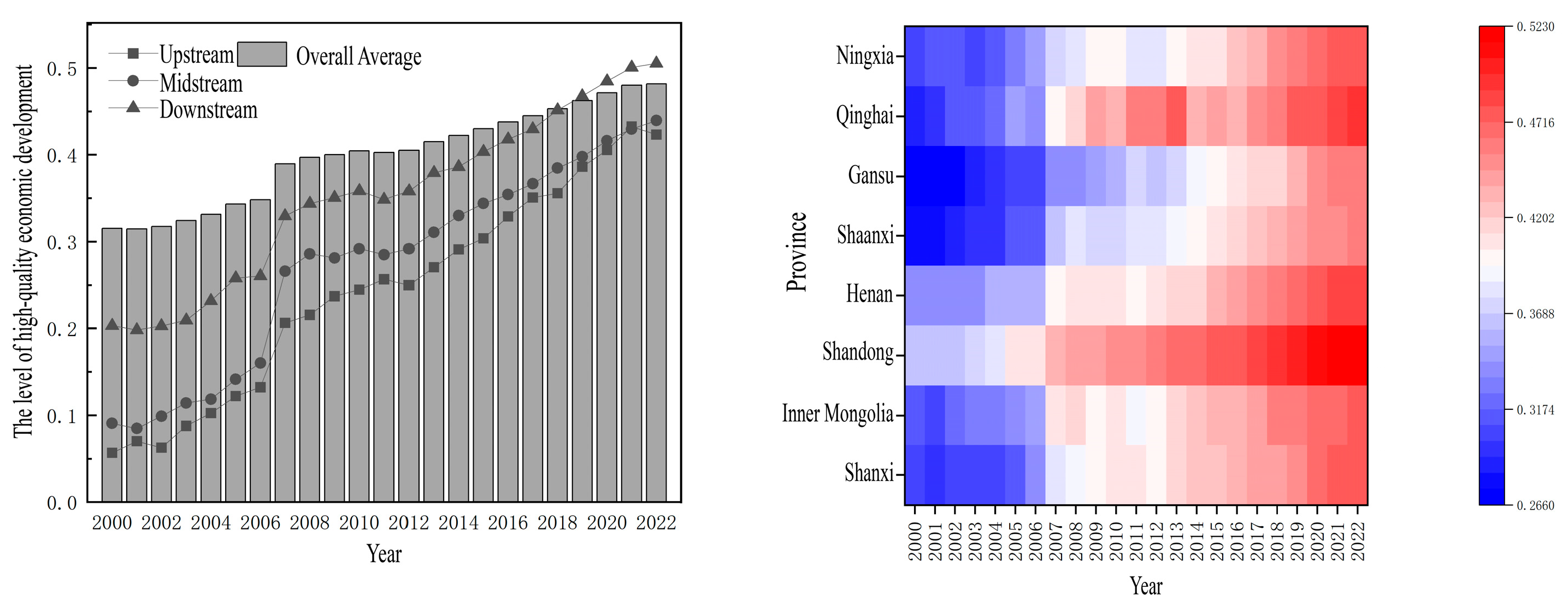

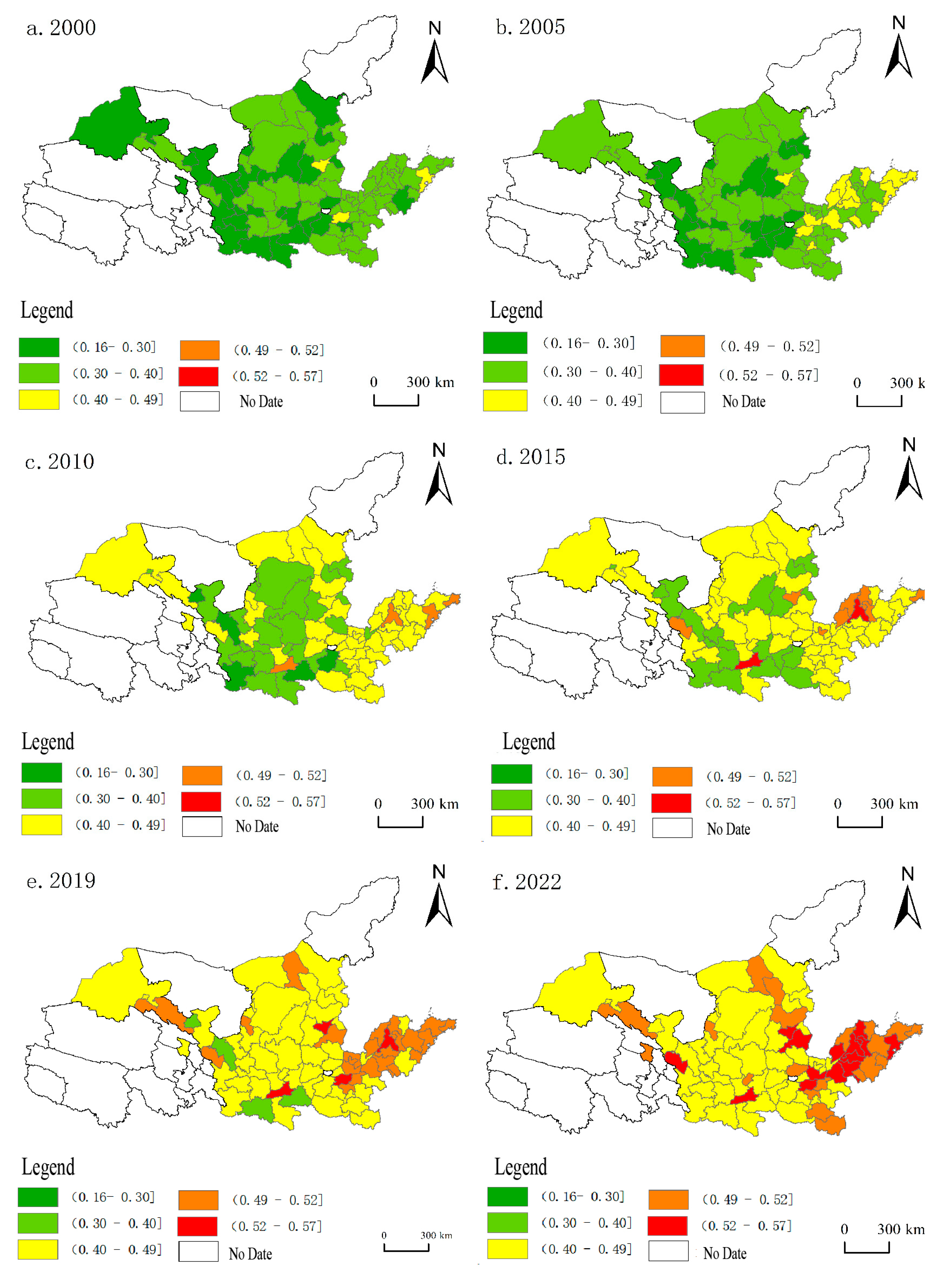
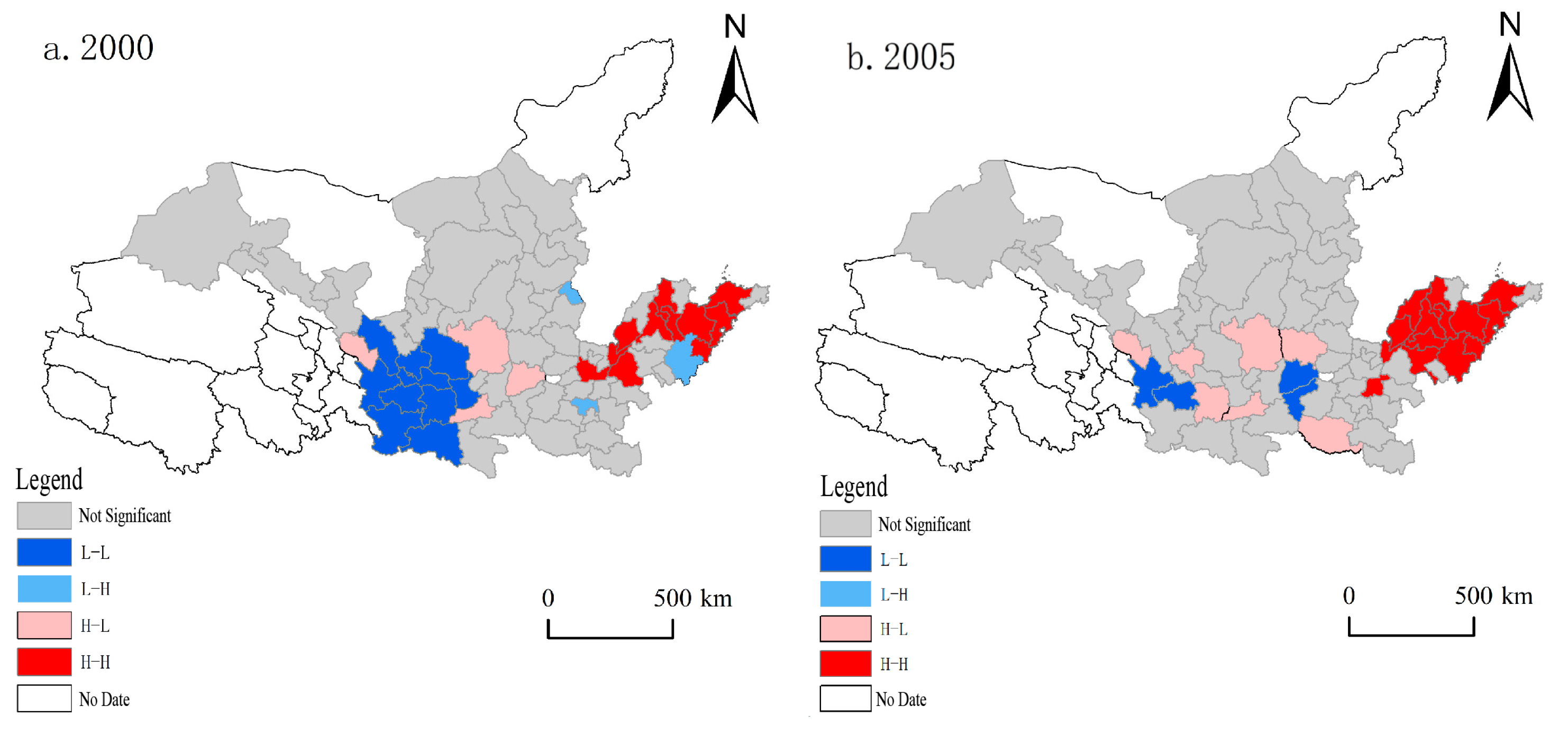

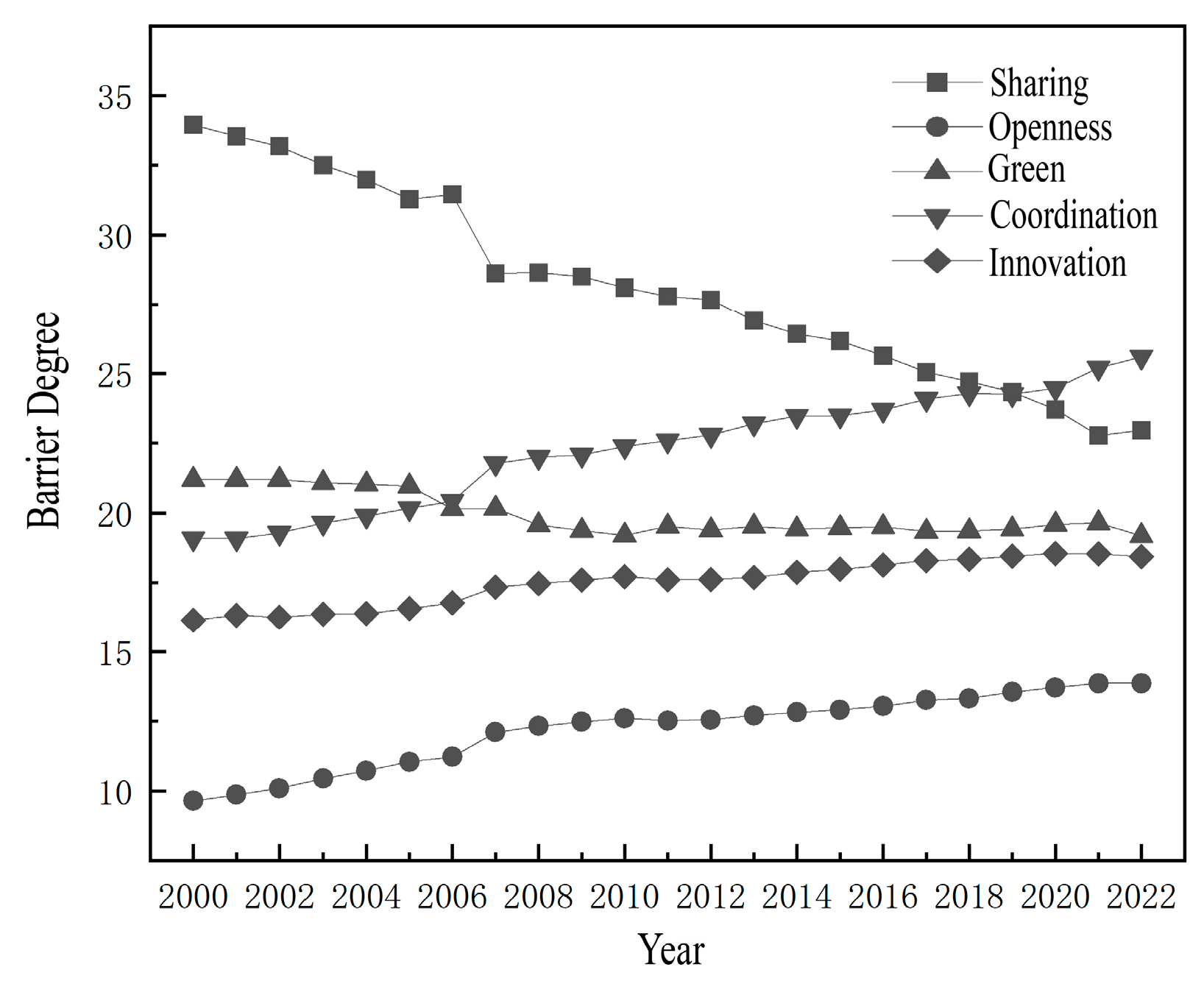
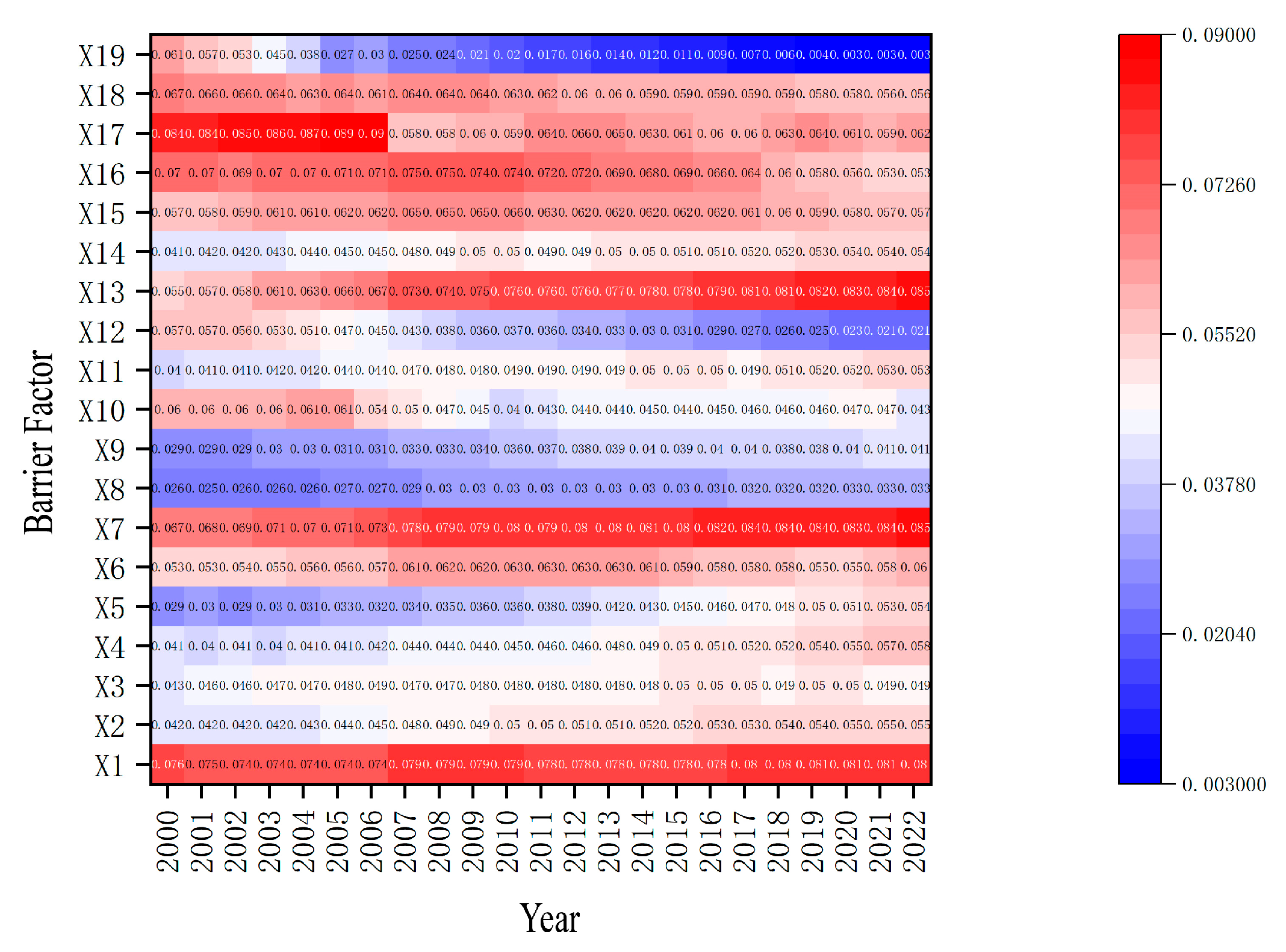
| Standardized Layer | Indicator Level | Indicator Properties | Weights |
|---|---|---|---|
| Innovation | X1: Human capital level (persons) | + | 0.0568 |
| X2: Financial expenditure on science and technology/local general public budget expenditure (%) | + | 0.0349 | |
| X3: Number of invention patents authorized for 10,000 people (pieces) | + | 0.0332 | |
| Coordination | X4: Urban–rural income gap (%) | − | 0.0479 |
| X5: Urban–rural consumption gap (%) | − | 0.0619 | |
| X6: Index of industrial advancement | + | 0.0397 | |
| X7: Industrial rationalization index | + | 0.0434 | |
| Green | X8: Industrial sulfur dioxide emissions per unit of GDP (kg/million yuan) | − | 0.0161 |
| X9: Share of energy-saving (ecological) environmental protection expenditure in financial expenditure (%) | + | 0.0264 | |
| X10: Comprehensive utilization rate of general industrial solid waste (%) | + | 0.0762 | |
| X11: Water consumption per unit of GDP (10,000 cubic meters/million yuan) | − | 0.1056 | |
| X12: Greening coverage rate of built-up areas (%) | + | 0.0667 | |
| Openness | X13: Total import and export of goods as a share of GDP (%) | + | 0.0503 |
| X14: Actual utilization of foreign direct investment/GDP (%) | + | 0.0333 | |
| Sharing | X15: Number of hospital doctors per 10,000 people (persons) | + | 0.05 |
| X16: Internet broadband access users per 10,000 people (households per 10,000 people) | + | 0.0518 | |
| X17: Road area per capita (m2/person) | + | 0.0741 | |
| X18: Share of social security and employment expenditure in fiscal expenditure (%) | + | 0.0532 | |
| X19: Gas penetration rate (%) | + | 0.0786 |
| Vintages | Moran’s I | p-Value | Z-Value | Vintages | Moran’s I | p-Value | Z-Value |
|---|---|---|---|---|---|---|---|
| 2000 | 0.2937 | 0.001 | 4.1047 | 2012 | 0.3667 | 0.001 | 4.9267 |
| 2001 | 0.27 | 0.002 | 3.7506 | 2013 | 0.3868 | 0.001 | 5.2331 |
| 2002 | 0.295 | 0.002 | 4.065 | 2014 | 0.2983 | 0.001 | 4.0103 |
| 2003 | 0.2191 | 0.003 | 3.0212 | 2015 | 0.3202 | 0.001 | 4.3319 |
| 2004 | 0.272 | 0.001 | 3.6937 | 2016 | 0.273 | 0.001 | 3.7246 |
| 2005 | 0.316 | 0.001 | 4.2537 | 2017 | 0.2393 | 0.003 | 3.2487 |
| 2006 | 0.3529 | 0.001 | 4.7217 | 2018 | 0.3174 | 0.001 | 4.2822 |
| 2007 | 0.2875 | 0.001 | 3.8086 | 2019 | 0.2616 | 0.001 | 3.5601 |
| 2008 | 0.2652 | 0.001 | 3.6455 | 2020 | 0.2564 | 0.002 | 3.4293 |
| 2009 | 0.3218 | 0.001 | 4.3344 | 2021 | 0.247 | 0.002 | 3.2811 |
| 2010 | 0.3442 | 0.001 | 4.7119 | 2022 | 0.2878 | 0.001 | 3.8462 |
| 2011 | 0.3236 | 0.001 | 4.3213 |
| t/(t + 1) | I | II | III | IV |
|---|---|---|---|---|
| I | 0.833 | 0.16 | 0.007 | 0 |
| II | 0.048 | 0.728 | 0.218 | 0.007 |
| III | 0 | 0.07 | 0.756 | 0.173 |
| IV | 0 | 0 | 0.047 | 0.953 |
| Neighborhood | t/(t + 1) | I | II | III | IV |
|---|---|---|---|---|---|
| I | I | 0.902 | 0.088 | 0.009 | 0 |
| II | 0.068 | 0.796 | 0.107 | 0.029 | |
| III | 0 | 0.091 | 0.818 | 0.091 | |
| IV | 0 | 0 | 0 | 1 | |
| II | I | 0.693 | 0.307 | 0 | 0 |
| II | 0.057 | 0.722 | 0.222 | 0 | |
| III | 0 | 0.172 | 0.707 | 0.121 | |
| IV | 0 | 0 | 0.194 | 0.806 | |
| III | I | 0.364 | 0.636 | 0 | 0 |
| II | 0.009 | 0.701 | 0.29 | 0 | |
| III | 0 | 0.032 | 0.782 | 0.185 | |
| IV | 0 | 0 | 0.102 | 0.898 | |
| IV | I | 0 | 1 | 0 | 0 |
| II | 0.053 | 0.579 | 0.368 | 0 | |
| III | 0 | 0.014 | 0.74 | 0.247 | |
| IV | 0 | 0 | 0.004 | 0.996 |
Disclaimer/Publisher’s Note: The statements, opinions and data contained in all publications are solely those of the individual author(s) and contributor(s) and not of MDPI and/or the editor(s). MDPI and/or the editor(s) disclaim responsibility for any injury to people or property resulting from any ideas, methods, instructions or products referred to in the content. |
© 2025 by the authors. Licensee MDPI, Basel, Switzerland. This article is an open access article distributed under the terms and conditions of the Creative Commons Attribution (CC BY) license (https://creativecommons.org/licenses/by/4.0/).
Share and Cite
Wu, X.; Wang, C.; Jin, Z.; Qi, G. Spatio-Temporal Evolution and Identification of Obstacles to High-Quality Economic Development in the Yellow River Basin. Sustainability 2025, 17, 4811. https://doi.org/10.3390/su17114811
Wu X, Wang C, Jin Z, Qi G. Spatio-Temporal Evolution and Identification of Obstacles to High-Quality Economic Development in the Yellow River Basin. Sustainability. 2025; 17(11):4811. https://doi.org/10.3390/su17114811
Chicago/Turabian StyleWu, Xiaoyu, Chengxin Wang, Zhenxing Jin, and Guangzhi Qi. 2025. "Spatio-Temporal Evolution and Identification of Obstacles to High-Quality Economic Development in the Yellow River Basin" Sustainability 17, no. 11: 4811. https://doi.org/10.3390/su17114811
APA StyleWu, X., Wang, C., Jin, Z., & Qi, G. (2025). Spatio-Temporal Evolution and Identification of Obstacles to High-Quality Economic Development in the Yellow River Basin. Sustainability, 17(11), 4811. https://doi.org/10.3390/su17114811







